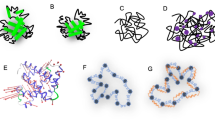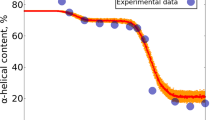Abstract
WE have noted a discrepancy between the models which are used to explain two kinds of experimental data related to protein unfolding. On the one hand, recent experiments on the reversible unfolding of the proteins ribonuclease, chymotrypsinogen and myoglobin, as revealed by changes in optical rotation and light absorption as a function of temperature or pH, demonstrate that such transitions can be described by a two state or all-or-none model1–3, in which partly folded molecules are not observed. On the other hand, there are the results on isotopic hydrogen exchange of proteins4,5. This exchange (for example, >NH + D2O→>ND + DHO) is possible only for hydrogen atoms which are exposed to the solvent. Hence a portion of the hydrogen atoms of a protein molecule exchanges more slowly than do exposed hydrogens, and the rate of exchange is equal to the product of the exchange rate for free hydrogens and the degree of unfolding (kobs=ko·θunf). Experimentally one observes an enormous variety of exchange rates among buried peptide group hydrogens, whereas the two state model predicts a single degree of unfolding as well as a single rate of unfolding and hence a single rate of exchange characteristic of all buried hydrogens.
This is a preview of subscription content, access via your institution
Access options
Subscribe to this journal
Receive 51 print issues and online access
$199.00 per year
only $3.90 per issue
Buy this article
- Purchase on Springer Link
- Instant access to full article PDF
Prices may be subject to local taxes which are calculated during checkout
Similar content being viewed by others
References
Brandts, J. F., J. Amer. Chem. Soc., 86, 4291 (1964).
Hermans, J., and Acampora, G., J. Amer. Chem. Soc., 89, 1547 (1967).
Tanford, C., Pain, R. H., and Otchin, N. S., J. Mol. Biol, 15, 489 (1966).
Hvidt, A., and Linderstrøm-Lang, K., Biochim. Biophys. Acta, 14, 574 (1954).
Hvidt, A., and Nielsen, S. O., Adv. Protein Chem., 21, 1287 (1966).
Hill, T. L., Statistical Mechanics (McGraw-Hill, New York, 1956).
Ising, E., Z. Phys., 31, 253 (1923).
Zimm, B. H., and Bragg, J. K., J. Chem. Phys., 31, 526 (1959).
Gibbs, J. H., and DiMarzio, E. A., J. Chem. Phys., 30, 271 (1959).
Peller, L., J. Phys. Chem., 63, 1194 (1959).
Hill, T. L., J. Chem. Phys., 30, 383 (1959).
Lumry, R., Biltonen, E., and Brandts, F. F., Biopolymers, 4, 917 (1966).
Tanford, C., Adv. Protein Chem., 23, 121 (1968).
Zimm, B. H., in Polyamino Acids, Polypeptides and Proteins (edit. by Stahmann, M. A.), 229 (Univ. of Wisconsin Press, Madison, 1962).
Zimm, B. H., Doty, P., and Iso, K., Proc. US Nat. Acad. Sci., 45, 1601 (1959).
Hermans, J., J. Amer. Chem. Soc., 88, 2418 (1966).
Karasz, F. E., and O'Reilly, J. M., Biopolymers, 4, 1015 (1966).
Ackermann, T., and Rüterjans, H., Z. Physik. Chemie, 41, 116 (1969).
Bryan, W. P., and Nielsen, S. O., Biochim. Biophys. Acta, 42, 552 (1960).
Benson, E. S., CR Trav. Lab. Carlsberg, 31, 235 (1959).
Benson, E. S., and Linderstrø;m-Lang, K., Biochim. Biophys. Acta, 32, 579 (1959).
Schechter, A. N., Morávek, L., and Anfinsen, C. B., Fed. Proc., 28, 344 (1969).
Author information
Authors and Affiliations
Rights and permissions
About this article
Cite this article
HERMANS, J., LOHR, D. & FERRO, D. Unfolding and Hydrogen Exchange of Proteins: the Three-dimensional Ising Lattice as a Model. Nature 224, 175–177 (1969). https://doi.org/10.1038/224175a0
Received:
Revised:
Issue Date:
DOI: https://doi.org/10.1038/224175a0
This article is cited by
-
The C-terminal domain of M. tuberculosis ECF sigma factor I (SigI) interferes in SigI-RNAP interaction
Journal of Molecular Modeling (2020)
-
Molecular dynamics simulations of the Bcl-2 protein to predict the structure of its unordered flexible loop domain
Journal of Molecular Modeling (2012)
-
Insight into the interaction sites between fatty acid binding proteins and their ligands
Journal of Molecular Modeling (2010)
-
Molecular dynamics study of the interaction between fatty acid binding proteins with palmitate mini-micelles
Molecular and Cellular Biochemistry (2009)
-
Protein Surface Dynamics: Interaction with Water and Small Solutes
Journal of Biological Physics (2005)
Comments
By submitting a comment you agree to abide by our Terms and Community Guidelines. If you find something abusive or that does not comply with our terms or guidelines please flag it as inappropriate.



